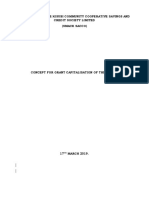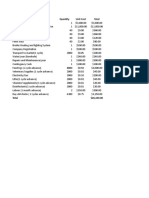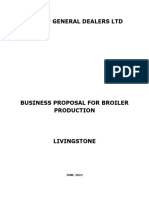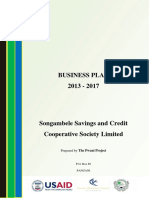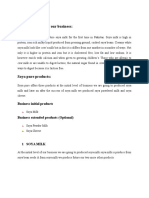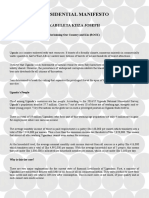Banking: Islamic Banking: Institute of Business Administration (Iba), Ju
Banking: Islamic Banking: Institute of Business Administration (Iba), Ju
Uploaded by
YeasminAkterCopyright:
Available Formats
Banking: Islamic Banking: Institute of Business Administration (Iba), Ju
Banking: Islamic Banking: Institute of Business Administration (Iba), Ju
Uploaded by
YeasminAkterOriginal Title
Copyright
Available Formats
Share this document
Did you find this document useful?
Is this content inappropriate?
Copyright:
Available Formats
Banking: Islamic Banking: Institute of Business Administration (Iba), Ju
Banking: Islamic Banking: Institute of Business Administration (Iba), Ju
Uploaded by
YeasminAkterCopyright:
Available Formats
INSTITUTE OF BUSINESS
ADMINISTRATION (IBA), JU
BANKING: ISLAMIC BANKING
BY: Yeasmin Akter, ID-2357, 21
st
Batch
Unit Coordinator: MD. Alamgir Hossen
Commercial Bank Management
Date of Submission: 11-05-2014
ISLAMIC BANKING
Definition
A banking system that is based on the principles of Islamic law (also known Shariah) and guided by
Islamic economics. Two basic principles behind Islamic banking are the sharing of profit and loss and,
significantly, the prohibition of the collection and payment of interest. Collecting interest is not
permitted under Islamic law.
Investopedia explains 'Islamic Banking'
Here's an example of how the Islamic banking system uses methods of profit/loss sharing to facilitate
financial transactions: for some types of loans, the borrower only needs to pay back the amount owed
to the lender, but the borrower can choose to pay the lender a small amount of money to serve as a
gratuity.
Current practices
Generally speaking, all interest-free banks agree on the basic principles. However, individual banks
differ in their application. These differences are due to several reasons including the laws of the
country, objectives of the different banks, individual banks circumstances and experiences, the need
to interact with other interest-based banks, etc.
1. Deposit accounts
All the Islamic banks have three kinds of deposit accounts: current, savings and investment.
Current accounts
Current or demand deposit accounts are virtually the same as in all conventional banks. Deposit is
guaranteed.
Savings accounts
Savings deposit accounts operate in different ways. In some banks, the depositors allow the banks to
use their money but they obtain a guarantee of getting the full amount back from the bank. Banks
adopt several methods of inducing their clients to deposit with them, but no profit is promised. In
others, savings accounts are treated as investment accounts but with less stringent conditions as to
withdrawals and minimum balance. Capital is not guaranteed but the banks take care to invest money
from such accounts in relatively risk-free short-term projects. As such lower profit rates are expected
and that too only on a portion of the average minimum balance on the ground that a high level of
reserves needs to be kept at all times to meet withdrawal demands.
Investment account
Investment deposits are accepted for a fixed or unlimited period of time and the investors agree in
advance to share the profit (or loss) in a given proportion with the bank. Capital is not guaranteed.
2 .Modes of financing
Banks adopt several modes of acquiring assets or financing projects. But they can be broadly
categorised into three areas: investment, trade and lending.
Investment financing
This is done in three main ways:
a) Musharaka where a bank may join another entity to set up a joint venture, both parties
participating in the various aspects of the project in varying degrees. Profit and loss are shared in
a pre-arranged fashion. This is not very different from the joint venture concept. The venture is an
independent legal entity and the bank may withdraw gradually after an initial period
b) Mudarabha where the bank contributes the finance and the client provides the expertise,
management and labour. Profits are shared by both the partners in a pre-arranged proportion, but
when a loss occurs the total loss is borne by the bank.
c) Financing on the basis of an estimated rate of return. Under this scheme, the bank estimates the
expected rate of return on the specific project it is asked to finance and provides financing on the
understanding that at least that rate is payable to the bank. (Perhaps this rate is negotiable.) If the
project ends up in a profit more than the estimated rate the excess goes to the client. If the profit
is less than the estimate the bank will accept the lower rate. In case a loss is suffered the bank will
take a share in it.
Trade financing
This is also done in several ways. The main ones are:
a) Mark-up where the bank buys an item for a client and the client agrees to repay the bank the
price and an agreed profit later on.
b) Leasing where the bank buys an item for a client and leases it to him for an agreed period and at
the end of that period the lessee pays the balance on the price agreed at the beginning an becomes the
owner of the item.
c) Hire-purchase where the bank buys an item for the client and hires it to him for an agreed rent
and period, and at the end of that period the client automatically becomes the owner of the item.
d) Sell-and-buy-back where a client sells one of his properties to the bank for an agreed price
payable now on condition that he will buy the property back after certain time for an agreed price
e) Letters of credit where the bank guarantees the import of an item using its own funds for a
client, on the basis of sharing the profit from the sale of this item or on a mark-up basis.
Lending
Main forms of Lending are:
a) Loans with a service charge where the bank lends money without interest but they cover their
expenses by levying a service charge. This charge may be subject to a maximum set by the authorities.
b) No-cost loans where each bank is expected to set aside a part of their funds to grant no-cost
loans to needy persons such as small farmers, entrepreneurs, producers, etc. and to needy consumers.
c) Overdrafts also are to be provided, subject to a certain maximum, free of charge.
3. Services
Other banking services such as money transfers, bill collections, trade in foreign currencies at spot
rate etc. where the banks own money is not involved are provided on a commission or charges basis.
Problems in implementing the PLS scheme
Several writers have attempted to show, with varying degrees of success, that Islamic Banking based
on the concept of profit and loss sharing (PLS) is theoretically superior to conventional banking from
different angles. In the over half-a-decade of full-scale experience in implementing the PLS scheme
the problems have begun to show up. If one goes by the experience of Pakistan as portrayed in the
papers presented at the conference held in Islamabad in 1992, the situation is very serious and no
satisfactory remedy seems to emerge. The major difficulties are displayed below:
1. Financing
There are four main areas where the Islamic banks find it difficult to finance under the PLS scheme:
a) participating in long-term low-yield projects, b) financing the small businessman, c) granting non-
participating loans to running businesses, and d) financing government borrowing.
Long-term projects
It is clear that less than 10 percent of the total assets goes into medium- and long-term investment.
Admittedly, the banks are unable or unwilling to participate in long-term projects. This is a very
unsatisfactory situation.
Small businesses
Small scale businesses form a major part of a countrys productive sector. Besides, they form a greater
number of the banks clientele. Yet it seems difficult to provide them with the necessary financing
under the PLS scheme, even though there is excess liquidity in the banks.
Running businesses
Running businesses frequently need short-term capital as well as working capital and ready cash for
miscellaneous on-the-spot purchases and sundry expenses. This is the daily reality in the business
world. Very little thought seems to have been given to this important aspect of the business worlds
requirement. The PLS scheme is not geared to cater to this need. Even if there is complete trust and
exchange of information between the bank and the business it is nearly impossible or prohibitively
costly to estimate the contribution of such short-term financing on the return of a given business.
Neither is the much used mark-up system suitable in this case. It looks unlikely to be able to arrive at
general rules to cover all the different situations.
Government borrowing
In all countries the Government accounts for a major component of the demand for credit -- both
short-term and long-term. Unlike business loans these borrowings are not always for investment
purposes, nor for investment in productive enterprises. Even when invested in productive enterprises
they are generally of a longer-term type and of low yield. This latter only multiplies the difficulties in
estimating a rate of return on these loans if they are granted under the PLS scheme.
2. Legislation
Existing banking laws do not permit banks to engage directly in business enterprises using depositors
funds. But this is the basic asset acquiring method of Islamic banks. Therefore new legislation and/or
government authorization are necessary to establish such banks. In Iran a comprehensive legislation
was passed to establish Islamic banks. In Pakistan the Central Bank was authorized to take the
necessary steps. In other countries either the banks found ways of using existing regulations or were
given special accommodation. In all cases government intervention or active support was necessary to
establish Islamic banks working under the PLS scheme.
3. Involvement in specialized non-bank activities
Traditional banks do perform a certain amount of project evaluation when granting large medium-
and long-term loans. But doing such detailed evaluation as would be required to embark on a PLS
scheme, such as determining the rates of return and their time schedule, is beyond the scope of
conventional banks. So is the detailed accounting and monitoring necessary to determine the actual
performance.
Under Islamic banking these exercises are not limited to relatively few large loans but need to be
carried out on nearly all the advances made by the bank. Yet, widely acceptable and reliable
techniques are yet to be devised. This is confounded by the fact that no consensus has yet been
reached on the principles. Both the unprecedented nature of the task as well as the huge amount of
work that need be done and the trained and experienced personnel needed to carry them out seems a
daunting prospect.
4. Re-training of staff
The bank staff will have to acquire many new skills and learn new procedures to operate the Islamic
banking system. This is a time consuming process which is aggravated by two other factors. One, the
sheer number of persons that need to be re-trained and, two, the additional staff that need to be
recruited and trained to carry out the increased work.
Principles are still to be laid down and techniques and procedures evolved to carry them out. It is only
after the satisfactory achievement of these that proper training can begin. This delay and the resulting
confusion appear to be among the main reasons for the banks to stick to modes of financing that are
close to the familiar interest-based modes.
5. Other disincentives
Among the other disincentives from the borrowers point of view are the need to disclose his accounts
to the bank if he were to borrow on the PLS basis, and the fear that eventually the tax authorities will
become wise to the extent of his business and the profits. Several writers have lashed out at the lack of
business ethics among the business community, but that is a fact of life at least for the foreseeable
future. There is a paucity of survey or case studies of clients to see their reaction to current modes of
financing. As such we are not aware of further disincentives that might be there.
Accounts
When a business is financed under the PLS scheme it is necessary that the actual profit/loss made
using that money be calculated. Though no satisfactory methods have yet been devised, the first
requirement for any such activity is to have the necessary accounts. On the borrowers side there are
two difficulties: one, many small-time businessmen do not keep any accounts, leave alone proper
accounts. The time and money costs will cut into his profits. Larger businesses do not like to disclose
their real accounts to anybody. On the banks side the effort and expense involved in checking the
accounts of many small accounts is prohibitive and will again cut into their own share of the profits.
Thus both sides would prefer to avoid having to calculate the actually realized profit/loss.
Tax
The bank is a big business and it has to declare its profit and loss and is legally required to present an
audited account of its operations. Once the banks accounts are known it doesnt take much for the tax
collectors to figure out the share of the businesses financed by the bank under the PLS scheme. Thus
its no surprise that businesses are not too very happy about the situation. The fact that suggestions
have been made to use the banks to collect taxes due has not helped the matter either.
6. Excess liquidity
Presence of excess liquidity is reported in nearly all Islamic banks. This is not due to reduced demand
for credit but the due to the inability of the banks to find clients willing to be funded under the new
modes of financing. Here we have a situation where there is money available on the one hand and
there is need for it on the other but the new rules stand in the way of bringing them together! This is a
very strange situation -- especially in the developing Muslim countries where money is at a premium
even for ordinary economic activities, leave alone development efforts. Removal of riba was expected
to ease such difficulties, not to aggravate the already existing ones!
7. Uneasy questions of morality
The practices in use by the Islamic banks have evoked questions of morality. Do the practices adopted
to avoid interest really do their job or is it simply a change of name? It suffices to quote a few authors.
Islamic banking in non-Muslim countries
The modern commercial banking system in nearly all countries of the world is mainly evolved from
and modeled on the practices in Europe, especially that in the United Kingdom. The philosophical
roots of this system revolve around the basic principles of capital certainty for depositors and
certainty as to the rate of return on deposits. In order to enforce these principles for the sake of the
depositors and to ensure the smooth functioning of the banking system Central Banks have been
vested with powers of supervision and control. All banks have to submit to the Central Bank rules.
Islamic banks which wish to operate in non-Muslim countries have some difficulties in complying
with these rules. We will examine below the salient features.
Certainty of capital and return
While the conventional banks guarantee the capital and rate of return, the Islamic banking system,
working on the principle of profit and loss sharing, cannot, by definition, guarantee any fixed rate of
return on deposits. Many Islamic banks do not guarantee the capital either, because if there is a loss it
has to be deducted from the capital. Thus the basic difference lies in the very roots of the two systems.
Consequently countries working under conventional laws are unable to grant permission to
institutions which wish to operate under the PLS scheme to functions as commercial banks. Two
official comments, one from the UK an the other from the USA suffice to illustrate this.
Supervision and control
Besides these, there are other concerns as well. One is the Central Bank supervision and control. This
mainly relates to liquidity requirements and adequacy of capital. These in turn depend on an
assessment of the value of
It is evident then that even if there is a desire to accommodate the Islamic system, the new procedures
that need be developed and the modifications that need be made to existing procedures are so large
that the chances of such accommodation in a cautious sector such as banking is very remote indeed.
Any relaxation of strict supervision is precluded because should an Islamic bank fail it would
undermine the confidence in the whole financial system, with which it is inevitably identified
The question has engaged the attention of Central Banks in Muslim countries as well. But reliable
satisfactory methods are still too developed.
Tax regulations
Another important consideration is the tax procedures in non-Muslim countries. While interest is a
passive income, profit is an earned income which is treated differently. In addition, in trade
financing there are title transfers twice -- once from seller to bank and then from bank to buyer -- and
therefore twice taxed on this account decreasing the profitability of the venture.
Conclusions
Islamic banking is a very young concept. Yet it has already been implemented as the only system in
two Muslim countries; there are Islamic banks in many Muslim countries and a few in non-Muslim
countries as well. Despite the successful acceptance there are problems. These problems are mainly in
the area of financing.
With only minor changes in their practices, Islamic banks can get rid of all their cumbersome,
burdensome and sometimes doubtful forms of financing and offer a clean and efficient interest-free
banking. All the necessary ingredients are already there. The modified system will make use of only
two forms of financing -- loans with a service charge and Muradabad participatory financing -- both
of which are fully accepted by all Muslim writers on the subject.
Such a system will offer an effective banking system where Islamic banking is obligatory and a
powerful alternative to conventional banking where both co-exist. Additionally, such a system will
have no problem in obtaining authorization to operate in non-Muslim countries.
Participatory financing is a unique feature of Islamic banking, and can offer responsible financing to
socially and economically relevant development projects. This is an additional service Islamic banks
offer over and above the traditional services provided by conventional commercial banks.
You might also like
- BylawsDocument32 pagesBylawsAnonymous L7XrxpeI1z0% (1)
- Smack Sacco Capitalisation ConceptDocument4 pagesSmack Sacco Capitalisation ConceptHSFXHFHXNo ratings yet
- Copy of Broiler FinancialsDocument5 pagesCopy of Broiler Financialskevior2No ratings yet
- Presented by DR Jey at BIRD LucknowDocument16 pagesPresented by DR Jey at BIRD LucknowvijayjeyaseelanNo ratings yet
- Business Plan 2013 - 2017Document23 pagesBusiness Plan 2013 - 2017adebo_yemiNo ratings yet
- Tamil Nadu Watershed Development AgencyDocument6 pagesTamil Nadu Watershed Development AgencyanbujeNo ratings yet
- Project Report For A Broiler Poultry Farm (500 Birds A Week)Document3 pagesProject Report For A Broiler Poultry Farm (500 Birds A Week)Rajesh Jangir100% (1)
- AROH Foundation: .A Ray of HopeDocument53 pagesAROH Foundation: .A Ray of HopePratima SinghNo ratings yet
- Concept Note Enable Youth Online Mentorship PlatformDocument3 pagesConcept Note Enable Youth Online Mentorship Platformade100% (1)
- Sacco Societies Act 2008Document139 pagesSacco Societies Act 2008James GikingoNo ratings yet
- Kanisa Sacco Information BookletDocument24 pagesKanisa Sacco Information BookletGideon M Kimari0% (1)
- Model PR For 10000 Layer UnitDocument3 pagesModel PR For 10000 Layer UnitpranayNo ratings yet
- Rotary Vijana Poa - Solving The Youth Unemployment Crisis in Uganda RC Kampala CentralDocument22 pagesRotary Vijana Poa - Solving The Youth Unemployment Crisis in Uganda RC Kampala CentralFlavia NampalaNo ratings yet
- EW Abridged Circular To Shareholders 25 JAN 2017 FINAL PDFDocument2 pagesEW Abridged Circular To Shareholders 25 JAN 2017 FINAL PDFGodknows MudzingwaNo ratings yet
- Project Proposal To Establish A Chicken ProjectDocument4 pagesProject Proposal To Establish A Chicken ProjectIsaac Chinoda100% (1)
- Cost Assumptions of Saline HatcheryDocument2 pagesCost Assumptions of Saline HatcheryEldhen Grencio OrgelaNo ratings yet
- BEEKEEPING Apiary Unit Model ProjectDocument2 pagesBEEKEEPING Apiary Unit Model ProjectArasu Don50% (2)
- Memorandum of Understanding Mou SampleDocument4 pagesMemorandum of Understanding Mou Samplenancy lullaNo ratings yet
- Project Report On PoultryDocument10 pagesProject Report On PoultryAnonymous cQ13WWeNo ratings yet
- Songambele Sacco Bizplan 508Document22 pagesSongambele Sacco Bizplan 508Andinet100% (2)
- Lending OperationsDocument54 pagesLending OperationsFaraz Ahmed FarooqiNo ratings yet
- Loan Policy PDFDocument3 pagesLoan Policy PDFVeeru Mudiraj0% (1)
- FINAL CITY DEVELOPMENT PLAN OCT 2021 (Repaired)Document295 pagesFINAL CITY DEVELOPMENT PLAN OCT 2021 (Repaired)Patrick Kagenda JobNo ratings yet
- Muyuni Business PlanDocument21 pagesMuyuni Business Plankantu1970No ratings yet
- Project Report For Broiler Farm: 4,000 NOS BIRDSDocument6 pagesProject Report For Broiler Farm: 4,000 NOS BIRDSManish GovilNo ratings yet
- Adjusted Feasibility Study of Kimcs - AbujaDocument54 pagesAdjusted Feasibility Study of Kimcs - AbujaGbadamosi OlusolaNo ratings yet
- HVCD Project ReportDocument40 pagesHVCD Project ReportAliNaqqashAnjumNo ratings yet
- Youths in Business (SME)Document2 pagesYouths in Business (SME)HumphreyNo ratings yet
- International Youth FoundationDocument6 pagesInternational Youth FoundationDenise LabagnaoNo ratings yet
- Livelihood Improvement of Tail End Farmers Through Water Harvesting - Final Report Janakalyan Volume IVDocument52 pagesLivelihood Improvement of Tail End Farmers Through Water Harvesting - Final Report Janakalyan Volume IVprasenrNo ratings yet
- The Parish Development Model - Civil Society's PositionDocument42 pagesThe Parish Development Model - Civil Society's PositionGCICNo ratings yet
- Chapter 1: The Principles of Lending and Lending BasicsDocument5 pagesChapter 1: The Principles of Lending and Lending Basicshesham zakiNo ratings yet
- SONGAMBELE SACCO Bizplan - 508 PDFDocument22 pagesSONGAMBELE SACCO Bizplan - 508 PDFmilesdeasis25100% (1)
- Manufacturing in Mbarara UgandaDocument76 pagesManufacturing in Mbarara UgandaThe Bartlett Development Planning Unit - UCL100% (1)
- State of The Microcredit Summit Campaign Report 2012Document74 pagesState of The Microcredit Summit Campaign Report 2012Microcredit Summit CampaignNo ratings yet
- Sacco Central AGM NOTICE 2023 Sgned PDFDocument2 pagesSacco Central AGM NOTICE 2023 Sgned PDFAmos NjeruNo ratings yet
- Credits and FinancialDocument25 pagesCredits and FinancialShenna obalesNo ratings yet
- Feasibility of Beekeeping in Manafwa and Swam Catchments, UgandaDocument32 pagesFeasibility of Beekeeping in Manafwa and Swam Catchments, UgandasedianpoNo ratings yet
- Iamu Posho MillDocument37 pagesIamu Posho MillOCHIENG NICHOLASNo ratings yet
- Cost Estimates AgriDocument17 pagesCost Estimates AgriIan Bernales OrigNo ratings yet
- Proj Agreement With StateDocument25 pagesProj Agreement With StatelamaNo ratings yet
- Business Studies MaterialDocument20 pagesBusiness Studies MaterialmwalepersuesNo ratings yet
- Example 1 of Memorandum of AgreementDocument2 pagesExample 1 of Memorandum of AgreementCeline FuentesNo ratings yet
- Leveraging NREGA Funds To Create Productive Agriculture Assets To Make Agriculture Profit-Making & Sustainable Vol VDocument90 pagesLeveraging NREGA Funds To Create Productive Agriculture Assets To Make Agriculture Profit-Making & Sustainable Vol VprasenrNo ratings yet
- Pig Farming AssamDocument3 pagesPig Farming AssamManjeet KumarNo ratings yet
- Chapter Six Agricultural Finance & Rural Credit Markets: 6.1 Why Do People Demand Credit in Rural AreasDocument12 pagesChapter Six Agricultural Finance & Rural Credit Markets: 6.1 Why Do People Demand Credit in Rural AreasHundeNo ratings yet
- 2021 Community Impact At-a-GlanceDocument5 pages2021 Community Impact At-a-GlanceNicole SwenartonNo ratings yet
- Governance Standards For SACCOsDocument16 pagesGovernance Standards For SACCOsKivumbi WilliamNo ratings yet
- Brief Description of Our BusinessDocument14 pagesBrief Description of Our Businessmughni5000No ratings yet
- Agricultural FinanceDocument8 pagesAgricultural FinanceYayah Koroma100% (1)
- SME Incubator in Djibouti - TPSDE Facility - Final 12092017-ENGDocument34 pagesSME Incubator in Djibouti - TPSDE Facility - Final 12092017-ENGSadik AdenNo ratings yet
- Debt Relief For Rwanda: An Opportunity For Peacebuilding and ReconstructionDocument18 pagesDebt Relief For Rwanda: An Opportunity For Peacebuilding and ReconstructionOxfamNo ratings yet
- ZAMG Farm Business Plan 1Document63 pagesZAMG Farm Business Plan 1Yoseph MelesseNo ratings yet
- Business Proposal of CompanyDocument33 pagesBusiness Proposal of Companyzeeshan_220No ratings yet
- Kabuleta Kiiza Joseph ManifestoDocument27 pagesKabuleta Kiiza Joseph ManifestoAfrican Centre for Media ExcellenceNo ratings yet
- A Plan to Save the Planet: How to resolve climate change at the lowest cost.From EverandA Plan to Save the Planet: How to resolve climate change at the lowest cost.No ratings yet
- Contract Farming for Better Farmer-Enterprise Partnerships: ADB's Experience in the People's Republic of ChinaFrom EverandContract Farming for Better Farmer-Enterprise Partnerships: ADB's Experience in the People's Republic of ChinaNo ratings yet
- Assessment of Microinsurance as Emerging Microfinance Service for the Poor: The Case of the PhilippinesFrom EverandAssessment of Microinsurance as Emerging Microfinance Service for the Poor: The Case of the PhilippinesNo ratings yet
- Decoding DCF: A Beginner's Guide to Discounted Cash Flow AnalysisFrom EverandDecoding DCF: A Beginner's Guide to Discounted Cash Flow AnalysisNo ratings yet

